|
Tags: ecology | geography | Jade Mountain | Mount Ali
I. Preface
Ilha Formosa
In 1544, when Portuguese sailors first saw Taiwan from the sea, they marveled at the sight and cried out, "Ilha Formosa" ("beautiful island"). At that moment, Taiwan became a part of the international community.
But, Taiwan's integration into the world happened much earlier than that. It may trace back a million years. About 6.5 million years ago, when the Eurasian tectonic plate collided with the Philippine plate, Taiwan was born in the depths of the Pacific. Four million years later, this land mass popped out of the sea. Thereafter, the land rose to 4,000 meters above sea level over the next 2.5 million years. The highest point of that landmass is today called Jade Mountain.
Taiwan has an area of only 36,000 square kilometers. The Tropic of Cancer cuts through the southern part of the island. It is situated in the subtropical climate zone. Topographically, it is a land of high mountains, not a few of which tower more than 3,000 meters. Its topographic diversity means that tropical, subtropical, temperate, and frigid climate zones can all be found in Taiwan. All types of forests grow in Taiwan, from forests of evergreens found in the cold high mountains to deciduous forests in the warm tropical lowlands. These great ecological differences have given rise to a great diversity of life existing at different altitudes.
It is interesting to note that Taiwan, though small, is home to such a great variety of ecosystems. Thanks to its geographic position and mountainous topography, it plays the role of a biological Noah's ark.
Taiwan's forests provide a suitable environment for the existence of a great variety of plant and animal life. The earth has witnessed several Ice Ages, but Taiwan has never once been buried by glaciers, sparing its wildlife from the threat of extinction. It has allowed a number of rare and valuable species to survive. During several Ice Ages, while Taiwan was still connected with the Asian mainland, it served as a refuge for northern species that retreated south. This is what caused Taiwan to be home to such biological diversity.
There are more than 4,000 kinds of vascular bundle plants, over 60 mammals, nearly 500 kinds of birds, over 150 of fish, 30 kinds of amphibians, some 30 kinds of lizards, 45 kinds of snakes, 5 kinds of turtles, and more than 17,000 kinds of insects on Taiwan. It could be said that Taiwan's beauty lies in its biological bonanza as well as its environment.
Taiwan has one of the highest proportions of endemic species of anywhere in the world. Of the more than 4,000 endemic plants, more than 1,000 are unique to Taiwan. This high proportion is a blessing bestowed by Taiwan's topographic environment.
II. Tropical Kenting
|

Kenting
Photo by: GIO Photographer (1992-05-17)
|
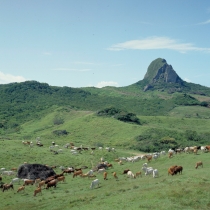
Kenting
Photo by: GIO Photographer (1992-05-17)
|

Kenting
Photo by: GIO Photographer (2002-06-14)
|
|

Kenting
Photo by: GIO Photographer
|

Kenting
Photo by: GIO Photographer
|

Kenting
Photo by: GIO Photographer
|
Undoubtedly, the last part of Venus that rose above the surface of the ocean was her pedestal, which holds high the weight of the whole body. This is Kenting, the southernmost point of Taiwan’s ecological gene pool.
Kenting rounds out Taiwan's ecosystem. If not for Kenting, the tropics would not be represented in Taiwan. Kenting is the northernmost point in the world in which tropical flora and fauna may be found.
Ocean currents bring plants from the South Seas to the Ouluanpi and Maobitou Peninsulas. Among them are Indian barringtonia (Barringtonia asiatica), sea hearse (Hernanadia nymphaeifolia), and looking-glass tree (Heritiera littoralis), which have made Kenting the northernmost point globally where a tropical coastal forest thrives.
Let's take a look at the most interesting tropical coastal plants. The Indian barringtonia is the "Flower of Kenting." It has more than 400 stamens but only one pistil, which, in a fashion, can boast about its great number of boyfriends.
Kenting National Park consists of looking-glass trees, in addition to which the bear's paw fern, feeling right at home on the Hengchun Peninsula, thrives. The gigantic white fig tree (Fiscu vasculosa) is also a must-see.
The complete coral reef sitting off the coast is another special feature of Kenting. The squeezing together of the tectonic plates has gradually pushed up the coral reefs, resulting in the breaking and shifting of coral. The clearest evidence of this is seen at Maobitou (Cat's Nose) and Sail Rock.
Both Cat's Nose and Sail Rock are fallen pieces of coastal cliffs and are famous for their interesting shape. The 18-meter Sail Rock looks like a sailboat when seen from afar, whereas Cat's Nose divides the Bashi Channel from the Taiwan Strait. Cat's Nose bears wrinkles like the pleats of a skirt and therefore is also known as the fringed coral-reef coast. In truth, fringed coral reefs make up the entirety of the coast in the Kenting-Ouluanpi area.
A number of unusual plants grow on the coral reef, the most unique of which is the reef pemphis (Pemphis acidula), which thrives in both salt and water. This distinctive attribute has lent it a reputation as the "invincible warrior" of the coral reef. The silvery messerschmidia (Messerschmidia argentea) is the most common bush on the reef, forming a beautiful fence along Taiwan's coastline.
Along the bright, black coral reefs, wind-blown sand patches known as "mini-deserts" are also a unique feature. During the summer rainy season, rainwater carrying fine into the sea forms sandy rivers. This fine sand flows rapidly to the coast and creates nearly 100-meter-tall sand falls. In the winter, strong winds blowing from the northeast spread fine sand along the cliffs. Over time, the two-way movement of sand has created a spectacular, 1500-by-200-meter sand hill.
The foremost plant on the coral reef is the reef pemphis, whereas that on the beach is the beach morning glory (Ipomoea pescaprae subsp. brasiliensis), which sends out tendrils far and wide, weaving a net on the surface of the sand. Besides these, cerbera (Cerbera manghas), after being cast about on the sea, are scattered everywhere along the seashore.
Mt. Dajian at 318 meters is a Kenting landmark. Geologically different from its surroundings, it is called by geologists the "exotic block." The pastureland at the foot of Dajian was reclaimed by Han Chinese immigrants. Hence, the name of Kenting was derived. In Chinese, the word "ken" means to reclaim, while "ting" signifies males. It was during the period of Japanese colonization that this area was turned into a pasture. To this day, cattle and sheep can still be seen roaming about and grazing freely in the pasture, adding to Kenting's idyllic beauty.
Long ago, Kenting was not only beautiful but also magnificent, because it was the habitat of Formosan sika deers (Cervus nippon taiouanus Blyth). Savannas found in the semidesert belt are paradise for deer, as is the low-elevation savanna found in western Taiwan.
While Taiwan was under Dutch rule, the Dutch traded deer skins for silver with the Japanese. The animals were reduced greatly a result of the destruction of their habitat as well as of hunting. No wild Formosan sika deer remained by the time Kenting was named a national park. During the Japanese colonial era, many Formosan sika deers were raised in Japan and also in Taiwan. After the establishment of Kenting National park, steps were taken to reintroduce the deer to the area.
Less affected by the shrinking habitat in Kenting, however, have been the birds, especially the hawks and falcons that stop by in early autumn on their way from Siberia and Korea. Among them, the gray-faced buzzard eagles (Butastur indicus) constitute the largest number, most of them arriving around October 10, National Day. Therefore this species is also known as the National Day bird. Another popular species is the Taiwan blue magpie (Urocissa caerulea), an endemic species boasting blue feathers and a long tail. These birds are often seen standing in line on the hills around Kenting, presenting another beautiful natural scene.
Thanks to its geographic position, tropical climate, and varied geographic shapes and special species, Kenting was declared Taiwan's first national park on New Year's Day in 1984.
III. Soft-natured Mt. Ali
|

The natural scenery of Alishan (Mt. Ali) in 1981.
Photo by: GIO Photographer (1981-05-05)
|

Mt. Ali
Photo by: GIO Photographer (1994-10-16)
|

Mt. Ali
Photo by: GIO Photographer (1996-01-00)
|
|

Mt. Ali
Photo by: GIO Photographer (1997-03-28)
|
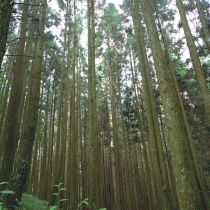
Mt. Ali
Photo by: GIO Photographer (1997-04-21)
|

Mt. Ali
Photo by: GIO Photographer
|
When Mt. Jade had shot out of the ocean and reached 1,000 meters in height, Mt. Ali raised it head to the west. If Mt. Jade is the head and shoulders of Venus, Mt. Ali is her bust and waist.
Mt. Ali stretches about 135 kilometers from Changhua and Nantou to Kaohsiung. It is composed of more than 20 peaks towering over 2,000 meters, but no individual peak bears the name Mt. Ali. Historical evidence suggests that the name came from the language of a local indigenous people. Long ago, the Tsou people were called Kali by the pingpu (plains) group then living near what is now Chiayi because the Tsou lived in the mountains to the east of Chiayi, which were known by the pingpu group as Kali. As time passed, the name of Kali Mountain was shortened to Ali Mountain.
At that time, the Ali Mountain area meant the foothills east of Chiayi. During the era of Japanese colonization, a vast expanse of cypress forest was discovered in the eastern part of this area, and so the area was made smaller and is the same as today's Alishan, or Mt. Ali. The Tsou tribe called the area "so-si-ga-na," meaning "the place that has many pine trees."
The tallest peak in the area stands at 2,800 meters, while most of the others are over 2,000 meters. Mountains at this altitude generate a large amount of mist and rainfall, which has allowed them to become home to world-renowned cypress forests.
The Japanese call cypress the "wood of fire," because it is oily and easy to burn. There are two types in Taiwan, the Taiwan yellow cypress and the Taiwan red cypress. Taiwanese call the former "thick bark" and the latter "thin bark."
Cypress grows very slow but has a remarkably long life. Most of the large, old trees are Taiwan red cypress, including the "divine tree" on Mt. Ali. This tree was discovered in 1906 and officially became a natural monument after worship rituals began to be performed before it. The tree was introduced to children in primary school textbooks. The "divine tree" was struck by lightning in 1953 and again in 1956, becoming a dead but still standing red cypress. The Forest Bureau tried to plant saplings on the top of the tree in an attempt to bring it back to life but failed. In July 1977, it collapsed in a storm. Finally, in June 1988, it was removed, becoming simply a part of history.
Over the last decade, people's attention has been taken away from the "divine tree" and refocused on two Taiwan red cypress trees, which are nicknamed the "husband-and wife-trees." The couple died in a forest fire in 1963. When Yushan National Park was established, they became a favorite of sightseers. It has been estimated that these trees, however, will not remain standing for much longer.
Cypress logging on Mt. Ali began in 1912 and by the end of the 1960s the mountain had been nearly razed clean. The hitherto luxuriantly growing cypress was replaced by the Japanese fir (Cryptomeria japonica). The majority of trees in the Mt. Ali area are now this thin, triangular variety.
In essence, the pride of Mt. Ali is its cypress forest, unique in the world. It best represents Taiwan's uniqueness and could make the list of natural heritage sites. It is distributed in the warm strip of the temperate zone at the border of the temperate zone and the subtropical zone, which is called the "mingled forest belt of needleleaf and broadleaf forests." Located within this forest belt are many rare living fossils, such as the Taiwan sassafras (Sassafras randaiensis), endemic to Taiwan.
The Taiwan pleione (Pleione formosana Hayata) also the pride of Taiwan and has made the list of world famous flowers.
Rhododendron morii Hay is another eye-catching flower, which, large and world-famous, is similar to the Yushan azalea. It becomes an eyecatcher on Mt. Ali when it blooms everywhere during the warm days of spring. The woolly-styled rhododendron (Rhododendron breviperulatum Hayata) and red hairy azalea (Rhododendron rubropilosum Hayata), which bloom in May, are the best alternatives to Rhododendron morii Hay. When autumn comes, the Formosan spiraea (Spiraea formosana), shady groundsel (Senecio nemorensis Linn), green maple (Acer serrulatus Hayata) and Taiwan stranvaesia (Stranvaesia niitakayamensis) vie for the attention of sightseers. As for Parachampionella flexicaulis, it seems to be less affected by seasonal climate changes. Except during extremely cold winters, its blue trumpet-shaped flowers can be seen anytime and anywhere.
IV. Icy Mt. Jade
|

Mt. Jade
Photo by: GIO Photographer (1995-02-00)
|
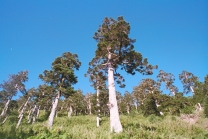
Mt. Jade
Photo by: GIO Photographer (1996-01-00)
|

Mt. Jade
Photo by: GIO Photographer (1996-01-00)
|
|
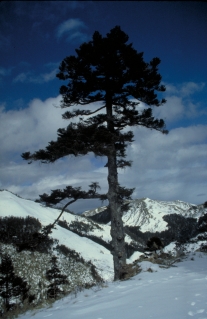
Mt. Jade
Photo by: GIO Photographer
|

Chiaming Lake, which has an elevation of 3260m.
Photo by: GIO Photographer (2002-12-26)
|
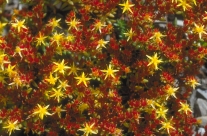
Mt. Jade
Photo by: GIO Photographer
|
About 2.5 million years ago, Taiwan rose as Venus out of the ocean. Mt. Jade, like the head of Venus, sprung forth. Today, it stands like a divine tower at 3,952 meters.
The tallest peak in northeast Asia, Mt. Jade assumes the royal air of a queen. Its lofty heights stretch to the north, south, east, and west, which act as guards for the main peak. In addition to the main peak there are 11 standing tall in every direction, forming a mountain chain. The east peak, the tallest of Taiwan's ten highest peaks, hovers near the main peak like a trusted bodyguard.
Located in the subtropics, Taiwan does not have a true winter, but its mountains make up for this lack by enriching the climatic diversity of the island. In other words, it is because of these high mountains that Taiwan can enjoy the climates of all four seasons, including the icy cold of winter. Mt. Jade, having a subfrigid climate, is the centerpiece of the Jade Mountain National Park, which was established on April 10, 1985.
The national park covers an area of more than 100,000 hectares. With Mt. Jade taking center stage, it extends to the southern section of the Central Mountain Range, and stretches through four counties—Chiayi, Nantou, Kaohsiung, and Hualien. The park includes some 30 peaks as well as Jiaming Lake and other highland lakes.
On Mt. Jade, it is easy to see the traces of the high-altitude and frigid-zone flora and fauna that settled in Taiwan. Some 65 million years ago, many plants perished along with dinosaurs but, fortunately, some gymnosperm, including the Cypressaceae and Pinaceae, survived and developed into unique varieties in Taiwan.
Over the past 1.5 million years, the world has experienced four glacier periods, and, as a result, many plant species resettled in Taiwan as they retreated from colder climes. The progenitors of the Taiwan cylindrical cypress (Juniperus squamata), Taiwan white fir (Tsuga chinensis), and Taiwan hemlock (Juniperus Sqyanata Lam) might be among those that migrated to Taiwan during the early part of one of these Ice Ages, making Taiwan the southernmost perimeter of their distribution.
These three species thrive at different altitudes, so when coming upon specimens of each, it is a simple matter to reckon the altitude. The Taiwan white fir, straight and beautiful, grows at the highest altitude and forms the most homogenous evergreen forest. In the upper portion of the cylindrical cypress forest belt, the Abies zone, Juniperus squamata is often found. Some endemic bushes and herbaceous plants also can be seen in the Abies zone, including the Yushan azalea (Rhododendron pseudochrysanthum Hayata), pearly everlasting (Anaphalis morrisonicola Hayata), and Yushan cane (Yushania niitakayamensis).
Growing together with Juniperus squamata are the moss species Berberis morrisonensis, Yushan azalea (Rhododendron pseudochrysanthum Hay), Sedum morrisonensis Hay, Angelica morrisonicola Hayata, Anaphalis morrisonicola, Nepal Anaphalis morrisonicola, and Leontopodium microphyllum.
In the subfrigid mountains, the Taiwan hemlock is the tallest tree, standing as high as 30 meters, but grows at the lowest altitude and prefers rocky ridges. People of the indigenous Atayal group call the tree "Yal Papa," because its roots holds the rocks tightly together just like a father does his household.
There was once a Taiwan hemlock forest just under the west peak of Mt. Jade, but it was destroyed by fire about a hundred years ago. The rain combined with the generally dry and cold climate have washed white the blackened remains of these trees, creating the now-famous white forest. In the hemlock forest, Gentiana arisanensis Hayata, Rhododendron morii Hay, Yushan cane, Rubus calycinoides Hayata, Sedum morrisonensis Hayata, Anaphalis morrisonicola (Anaphalis morrisonicola Hayata) and Taiwan pieris (Pieris taiwanensis Hay) are common sights.
Locally, the Taiwan pieris is referred to as Ma Zui Mu, literally the "drunken horse tree," because if a horse eats of the tree, it will appear drunk. In most cases, a plant is named after its nature, but there are also instances of plant nomenclature deriving from where the first specimen is discovered. Those plants named after Mt. Jade (those that have "Mt. Jade" or "Yushan" in their names) were first discovered by foreigners, indicating that this mountain and its varied ecology are known the world over.
In the hot summer, Mt. Jade remains as cool as high-latitude nations. Colorful flowers come into full bloom, just like in high-latitude nations. Because of the cool climate, plants at high altitudes can bloom only for a brief period, resulting in a scene in which hundreds of species of flower bloom as one. The Japanese described the scene as being like the Imperial Gardens. The most magnificent scenery is that of the Yushan azalea.
The Yushan, or Mt. Jade, azalea can grow to three meters. It normally blooms just at the cusp of summer. When this species comes into bloom, the mountains, the ridge of Taiwan's "roof," becomes as hundreds of Imperial Gardens all rolled into one.
Taiwan Image - Photo Archive
Text and images are provided by Ministry of Foreign Affairs, Republic of China (TAIWAN)
|





























